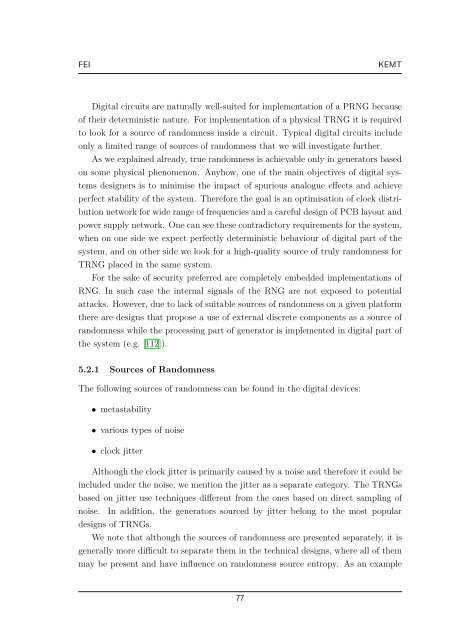1 Montgomery Modular Multiplication in Hard- ware
1 Montgomery Modular Multiplication in Hard- ware
1 Montgomery Modular Multiplication in Hard- ware
You also want an ePaper? Increase the reach of your titles
YUMPU automatically turns print PDFs into web optimized ePapers that Google loves.
FEI KEMT<br />
Digital circuits are naturally well-suited for implementation of a PRNG because<br />
of their determ<strong>in</strong>istic nature. For implementation of a physical TRNG it is required<br />
to look for a source of randomness <strong>in</strong>side a circuit. Typical digital circuits <strong>in</strong>clude<br />
only a limited range of sources of randomness that we will <strong>in</strong>vestigate further.<br />
As we expla<strong>in</strong>ed already, true randomness is achievable only <strong>in</strong> generators based<br />
on some physical phenomenon. Anyhow, one of the ma<strong>in</strong> objectives of digital sys-<br />
tems designers is to m<strong>in</strong>imise the impact of spurious analogue effects and achieve<br />
perfect stability of the system. Therefore the goal is an optimisation of clock distri-<br />
bution network for wide range of frequencies and a careful design of PCB layout and<br />
power supply network. One can see these contradictory requirements for the system,<br />
when on one side we expect perfectly determ<strong>in</strong>istic behaviour of digital part of the<br />
system, and on other side we look for a high-quality source of truly randomness for<br />
TRNG placed <strong>in</strong> the same system.<br />
For the sake of security preferred are completely embedded implementations of<br />
RNG. In such case the <strong>in</strong>ternal signals of the RNG are not exposed to potential<br />
attacks. However, due to lack of suitable sources of randomness on a given platform<br />
there are designs that propose a use of external discrete components as a source of<br />
randomness while the process<strong>in</strong>g part of generator is implemented <strong>in</strong> digital part of<br />
the system (e.g. [112]).<br />
5.2.1 Sources of Randomness<br />
The follow<strong>in</strong>g sources of randomness can be found <strong>in</strong> the digital devices:<br />
• metastability<br />
• various types of noise<br />
• clock jitter<br />
Although the clock jitter is primarily caused by a noise and therefore it could be<br />
<strong>in</strong>cluded under the noise, we mention the jitter as a separate category. The TRNGs<br />
based on jitter use techniques different from the ones based on direct sampl<strong>in</strong>g of<br />
noise. In addition, the generators sourced by jitter belong to the most popular<br />
designs of TRNGs.<br />
We note that although the sources of randomness are presented separately, it is<br />
generally more difficult to separate them <strong>in</strong> the technical designs, where all of them<br />
may be present and have <strong>in</strong>fluence on randomness source entropy. As an example<br />
77

















